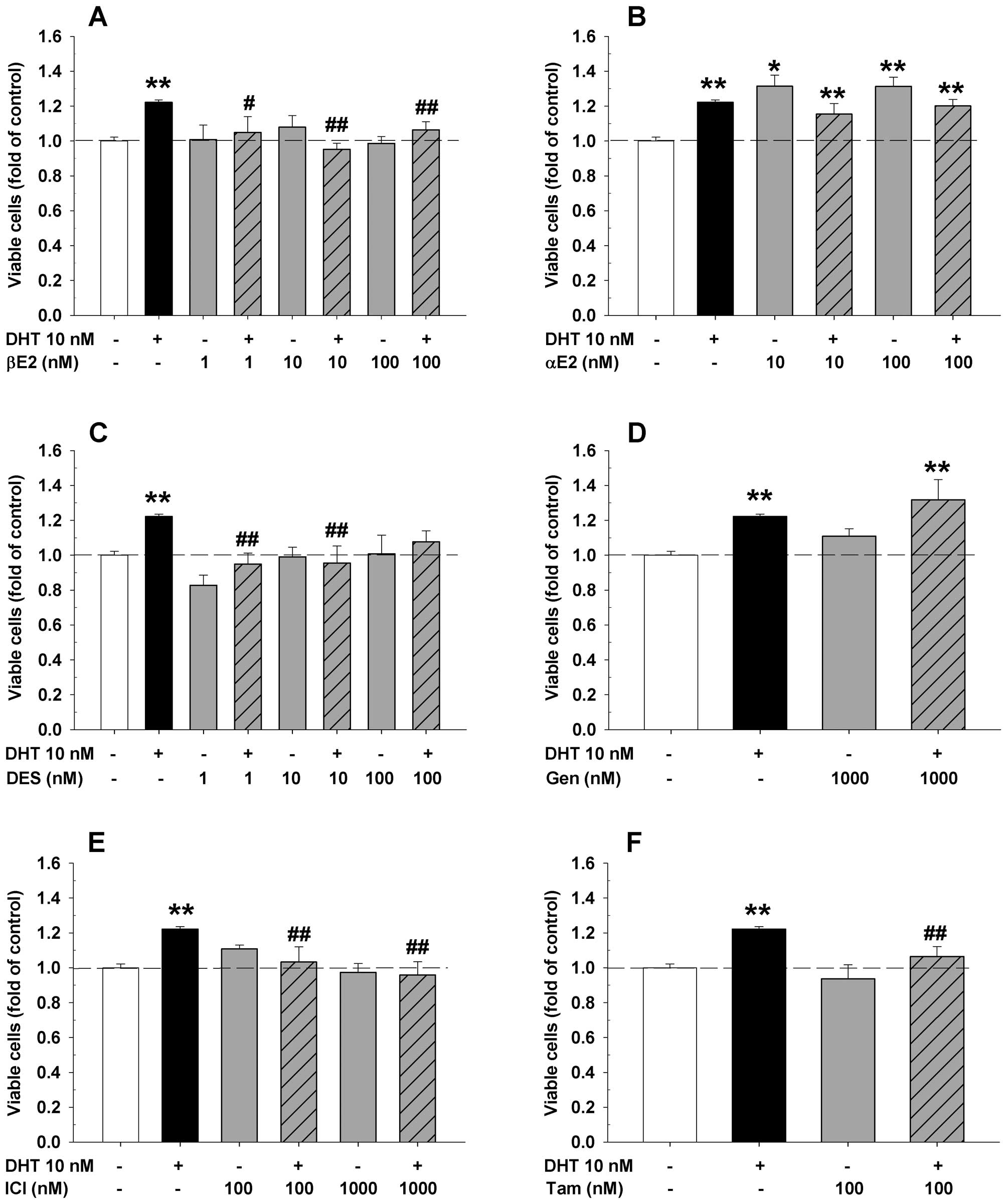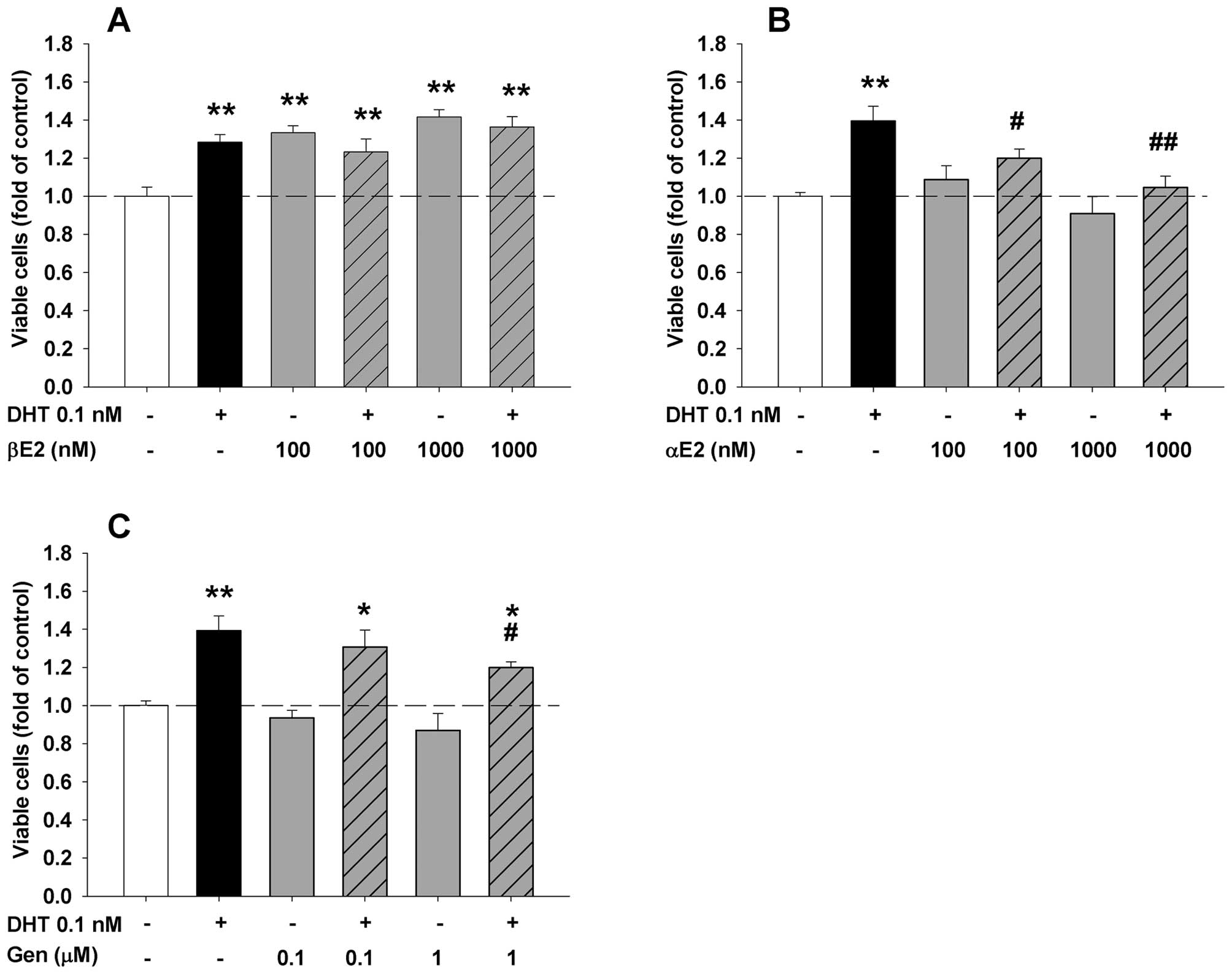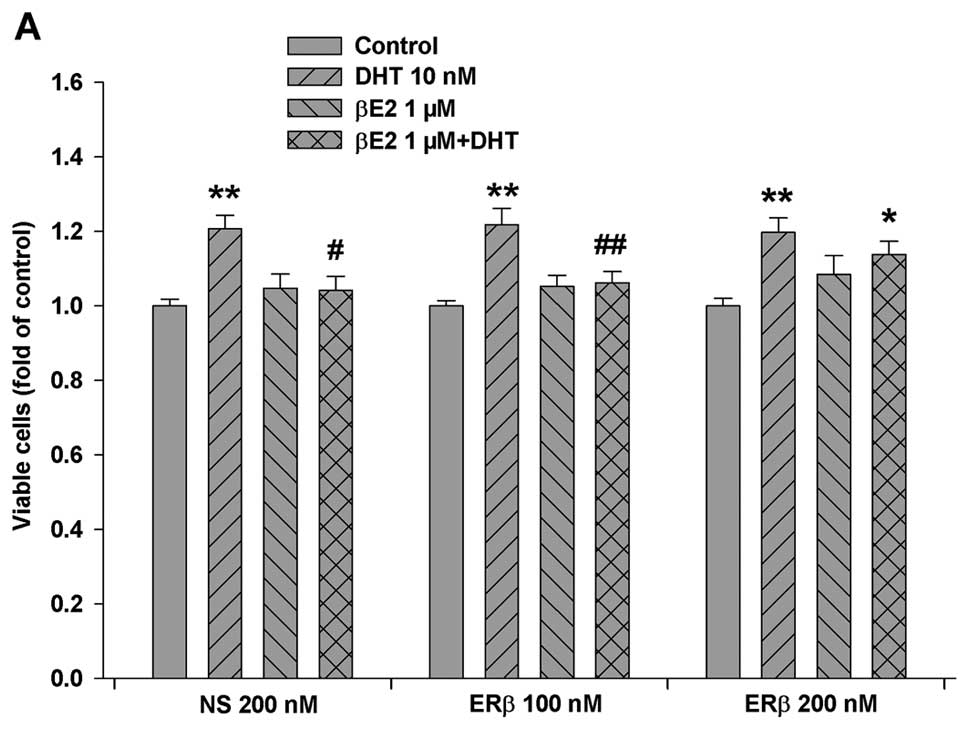|
1.
|
Jemal A, Bray F, Center MM, Ferlay J, Ward
E and Forman D: Global cancer statistics. CA Cancer J Clin.
61:69–90. 2011. View Article : Google Scholar
|
|
2.
|
Djulbegovic M, Beyth RJ, Neuberger MM,
Stoffs TL, Vieweg J, Djulbegovic B and Dahm P: Screening for
prostate cancer: systematic review and meta-analysis of randomised
controlled trials. BMJ. 341:c45432010. View Article : Google Scholar : PubMed/NCBI
|
|
3.
|
Ginzburg S and Albertsen PC: The timing
and extent of androgen deprivation therapy for prostate cancer:
weighing the clinical evidence. Endocrinol Metab Clin North Am.
40:615–623. 2011. View Article : Google Scholar : PubMed/NCBI
|
|
4.
|
Huggins C and Hodges CV: Studies on
prostatic cancer I. The effect of castration, of estrogen and of
androgen injection on serum phosphatases in metastatic carcinoma of
the prostate. Cancer Res. 1:293–297. 1941.
|
|
5.
|
Dowling AJ and Tannock IF: Systemic
treatment for prostate cancer. Cancer Treat Rev. 24:283–301. 1998.
View Article : Google Scholar
|
|
6.
|
Qiao Y, Zhang ZK, Cai LQ, Tan C,
Imperato-McGinley JL and Zhu YS: 17alpha-estradiol inhibits LAPC-4
prostatic tumor cell proliferation in cell cultures and tumor
growth in xenograft animals. Prostate. 67:1719–1728. 2007.
View Article : Google Scholar : PubMed/NCBI
|
|
7.
|
Zhu YS, Cai LQ, Huang Y, Fish J, Wang L,
Zhang ZK and Imperato-McGinley JL: Receptor isoform and
ligand-specific modulation of dihydrotestosterone-induced prostate
specific antigen gene expression and prostate tumor cell growth by
estrogens. J Androl. 26:500–508. 2005. View Article : Google Scholar : PubMed/NCBI
|
|
8.
|
The Coronary Drug Project: Findings
leading to discontinuation of the 2.5-mg day estrogen group. The
coronary Drug Project Research Group. JAMA. 226:652–657. 1973.
View Article : Google Scholar : PubMed/NCBI
|
|
9.
|
The Veterans Administration Co-operative
Urological Research Group: Treatment and survival of patients with
cancer of the prostate. Surg Gynecol Obstet. 124:1011–1017.
1967.PubMed/NCBI
|
|
10.
|
Ling S, Komesaroff P and Sudhir K:
Cellular mechanisms underlying the cardiovascular actions of
oestrogens. Clin Sci (Lond). 111:107–118. 2006. View Article : Google Scholar : PubMed/NCBI
|
|
11.
|
Ouyang P, Michos ED and Karas RH: Hormone
replacement therapy and the cardiovascular system lessons learned
and unanswered questions. J Am Coll Cardiol. 47:1741–1753. 2006.
View Article : Google Scholar : PubMed/NCBI
|
|
12.
|
Ross R: Atherosclerosis - an inflammatory
disease. N Engl J Med. 340:115–126. 1999. View Article : Google Scholar
|
|
13.
|
Moolman JA: Unravelling the
cardioprotective mechanism of action of estrogens. Cardiovasc Res.
69:777–780. 2006. View Article : Google Scholar : PubMed/NCBI
|
|
14.
|
Leung YK, Mak P, Hassan S and Ho SM:
Estrogen receptor (ER)-beta isoforms: a key to understanding
ER-beta signaling. Proc Natl Acad Sci USA. 103:13162–13167. 2006.
View Article : Google Scholar : PubMed/NCBI
|
|
15.
|
Nilsson S and Gustafsson JÅ: Estrogen
receptors: therapies targeted to receptor subtypes. Clin Pharmacol
Ther. 89:44–55. 2011. View Article : Google Scholar : PubMed/NCBI
|
|
16.
|
Matthews J and Gustafsson JA: Estrogen
signaling: a subtle balance between ER alpha and ER beta. Mol
Interv. 3:281–292. 2003. View Article : Google Scholar : PubMed/NCBI
|
|
17.
|
Sotoca AM, van den Berg H, Vervoort J, et
al: Influence of cellular ERalpha/ERbeta ratio on the
ERalpha-agonist induced proliferation of human T47D breast cancer
cells. Toxicol Sci. 105:303–311. 2008. View Article : Google Scholar : PubMed/NCBI
|
|
18.
|
Stein S, Zoltick B, Peacock T, et al:
Phase II trial of toremifene in androgen-independent prostate
cancer: a Penn cancer clinical trials group trial. Am J Clin Oncol.
24:283–285. 2001. View Article : Google Scholar : PubMed/NCBI
|
|
19.
|
Babiker FA, De Windt LJ, van Eickels M,
Grohe C, Meyer R and Doevendans PA: Estrogenic hormone action in
the heart: regulatory network and function. Cardiovasc Res.
53:709–719. 2002. View Article : Google Scholar : PubMed/NCBI
|
|
20.
|
Rossouw JE, Anderson GL, Prentice RL, et
al: Risks and benefits of estrogen plus progestin in healthy
postmenopausal women: principal results from the Women’s Health
Initiative randomized controlled trial. JAMA. 288:321–333.
2002.PubMed/NCBI
|
|
21.
|
Zhu Y, Bian Z, Lu P, et al: Abnormal
vascular function and hypertension in mice deficient in estrogen
receptor beta. Science. 295:505–508. 2002. View Article : Google Scholar : PubMed/NCBI
|
|
22.
|
Lau KM, LaSpina M, Long J and Ho SM:
Expression of estrogen receptor (ER)-alpha and ER-beta in normal
and malignant prostatic epithelial cells: regulation by methylation
and involvement in growth regulation. Cancer Res. 60:3175–3182.
2000.
|
|
23.
|
Nakajima Y, Akaogi K, Suzuki T, et al:
Estrogen regulates tumor growth through a nonclassical pathway that
includes the transcription factors ERβ and KLF5. Sci Signal.
4:ra222011.PubMed/NCBI
|
|
24.
|
Qiao Y, Wang L, Cai LQ, Tan C,
Imperato-McGinley J and Zhu YS: Inhibition of aberrant androgen
receptor induction of prostate specific antigen gene expression,
cell proliferation and tumor growth by 17α-estradiol in prostate
cancer. J Urol. 185:305–314. 2011.PubMed/NCBI
|
|
25.
|
Cai J, Hong Y, Weng C, Tan C,
Imperato-McGinley JL and Zhu YS: Androgen stimulates endothelial
cell proliferation via an androgen receptor-VEGF/cyclin A mediated
mechanism. Am J Physiol Heart Circ Physiol. 300:H1210–H1221. 2011.
View Article : Google Scholar : PubMed/NCBI
|
|
26.
|
Arnold JT, Liu X, Allen JD, Le H, McFann
KK and Blackman MR: Androgen receptor or estrogen receptor-beta
blockade alters DHEA-, DHT-, and E(2)-induced proliferation and PSA
production in human prostate cancer cells. Prostate. 67:1152–1162.
2007. View Article : Google Scholar : PubMed/NCBI
|
|
27.
|
Zhu YS and Pfaff DW: Differential
regulation of AP-1 DNA binding activity in rat hypothalamus and
pituitary by estrogen. Mol Brain Res. 55:115–125. 1998. View Article : Google Scholar : PubMed/NCBI
|
|
28.
|
Martin MB, Angeloni SV, Garcia-Morales P,
Sholler PF, Castro-Galache MD, Ferragut JA and Saceda M: Regulation
of estrogen receptor-alpha expression in MCF-7 cells by taxol. J
Endocrinol. 180:487–496. 2004. View Article : Google Scholar : PubMed/NCBI
|
|
29.
|
Collins L, Mohammed N, Ahmad T and Basaria
S: Androgen deprivation therapy for prostate cancer: implications
for cardiometabolic clinical care. J Endocrinol Invest. 35:332–339.
2012.PubMed/NCBI
|
|
30.
|
Sieveking DP, Lim P, Chow RW, et al: A
sex-specific role for androgens in angiogenesis. J Exp Med.
207:345–352. 2010. View Article : Google Scholar : PubMed/NCBI
|
|
31.
|
Panet-Raymond V, Gottlieb B, Beitel LK,
Pinsky L and Trifiro MA: Interactions between androgen and estrogen
receptors and the effects on their transactivational properties.
Mol Cell Endocrinol. 167:139–150. 2000. View Article : Google Scholar
|
|
32.
|
Sumanasekera WK, Sumanasekera GU,
Mattingly KA, Dougherty SM, Keynton RS and Klinge CM: Estradiol and
dihydrotestosterone regulate endothelial cell barrier function
after hypergravity-induced alterations in MAPK activity. Am J
Physiol Cell Physiol. 293:C566–C573. 2007. View Article : Google Scholar
|
|
33.
|
Bhattacharyya RS, Krishnan AV, Swami S and
Feldman D: Fulvestrant (ICI 182,780) down-regulates androgen
receptor expression and diminishes androgenic responses in LNCaP
human prostate cancer cells. Mol Cancer Ther. 5:1539–1549. 2006.
View Article : Google Scholar
|
|
34.
|
Bergan RC, Reed E, Myers CE, et al: A
phase II study of high-dose tamoxifen in patients with
hormone-refractory prostate cancer. Clin Cancer Res. 5:2366–2373.
1999.PubMed/NCBI
|
|
35.
|
Zhu YS and Imperato-McGinley JL:
5alpha-reductase isozymes and androgen actions in the prostate. Ann
NY Acad Sci. 1155:43–56. 2009. View Article : Google Scholar : PubMed/NCBI
|
|
36.
|
Harrington WR, Sheng S, Barnett DH, Petz
LN, Katzenellenbogen JA and Katzenellenbogen BS: Activities of
estrogen receptor alpha- and beta-selective ligands at diverse
estrogen responsive gene sites mediating transactivation or
transrepression. Mol Cell Endocrinol. 206:13–22. 2003. View Article : Google Scholar
|
|
37.
|
Kraichely DM, Sun J, Katzenellenbogen JA
and Katzenellenbogen BS: Conformational changes and coactivator
recruitment by novel ligands for estrogen receptor-alpha and
estrogen receptor-beta: correlations with biological character and
distinct differences among SRC coactivator family members.
Endocrinology. 141:3534–3545. 2000.
|
|
38.
|
Veldscholte J, Ris-Stalpers C, Kuiper GG,
et al: A mutation in the ligand binding domain of the androgen
receptor of human LNCaP cells affects steroid binding
characteristics and response to anti-androgens. Biochem Biophys Res
Commun. 173:534–540. 1990. View Article : Google Scholar
|
|
39.
|
Brzozowski AM, Pike AC, Dauter Z, et al:
Molecular basis of agonism and antagonism in the oestrogen
receptor. Nature. 389:753–758. 1997. View
Article : Google Scholar : PubMed/NCBI
|
|
40.
|
Dai SY, Burris TP, Dodge JA, et al: Unique
ligand binding patterns between estrogen receptor alpha and beta
revealed by hydrogen-deuterium exchange. Biochemistry.
48:9668–9676. 2009. View Article : Google Scholar : PubMed/NCBI
|
|
41.
|
Pike AC, Brzozowski AM, Hubbard RE, et al:
Structure of the ligand-binding domain of oestrogen receptor β in
the presence of a partial agonist and a full antagonist. EMBO J.
18:4608–4618. 1999.
|
|
42.
|
Margeat E, Bourdoncle A, Margueron R,
Poujol N, Cavailles V and Royer C: Ligands differentially modulate
the protein interactions of the human estrogen receptors alpha and
beta. J Mol Biol. 326:77–92. 2003. View Article : Google Scholar : PubMed/NCBI
|
|
43.
|
Shang YF and Brown M: Molecular
determinants for the tissue specificity of SERMs. Science.
295:2465–2468. 2002. View Article : Google Scholar : PubMed/NCBI
|
|
44.
|
Galderisi U, Jori FP and Giordano A: Cell
cycle regulation and neural differentiation. Oncogene.
22:5208–5219. 2003. View Article : Google Scholar : PubMed/NCBI
|
|
45.
|
Pestell RG, Albanese C, Reutens AT, Segall
JE, Lee RJ and Arnold A: The cyclins and cyclin-dependent kinase
inhibitors in hormonal regulation of proliferation and
differentiation. Endocr Rev. 20:501–534. 1999.PubMed/NCBI
|
|
46.
|
Yasmeen A, Berdel WE, Serve H and
Muller-Tidow C: E- and A-type cyclins as markers for cancer
diagnosis and prognosis. Expert Rev Mol Diagn. 3:617–633. 2003.
View Article : Google Scholar : PubMed/NCBI
|
|
47.
|
Wegiel B, Bjartell A, Tuomela J, et al:
Multiple cellular mechanisms related to cyclin A1 in prostate
cancer invasion and metastasis. J Natl Cancer Inst. 100:1022–1036.
2008. View Article : Google Scholar : PubMed/NCBI
|
|
48.
|
Ko YJ and Balk SP: Targeting steroid
hormone receptor pathways in the treatment of hormone dependent
cancers. Curr Pharm Biotechnol. 5:459–470. 2004. View Article : Google Scholar : PubMed/NCBI
|
|
49.
|
Li JJ, Li SA, Oberley TD and Parsons JA:
Carcinogenic activities of various steroidal and nonsteroidal
estrogens in the hamster kidney: relation to hormonal activity and
cell proliferation. Cancer Res. 55:4347–4351. 1995.PubMed/NCBI
|
|
50.
|
Freay AD, Curtis SW, Korach KS and Rubanyi
GM: Mechanism of vascular smooth muscle relaxation by estrogen in
depolarized rat and mouse aorta. Role of nuclear estrogen receptor
and Ca2+ uptake. Circ Res. 81:242–248. 1997. View Article : Google Scholar : PubMed/NCBI
|
|
51.
|
Dykens JA, Moos WH and Howell N:
Development of 17alpha-estradiol as a neuroprotective therapeutic
agent: Rationale and results from a phase I clinical study. Ann NY
Acad Sci. 1052:116–35. 2005. View Article : Google Scholar : PubMed/NCBI
|

















